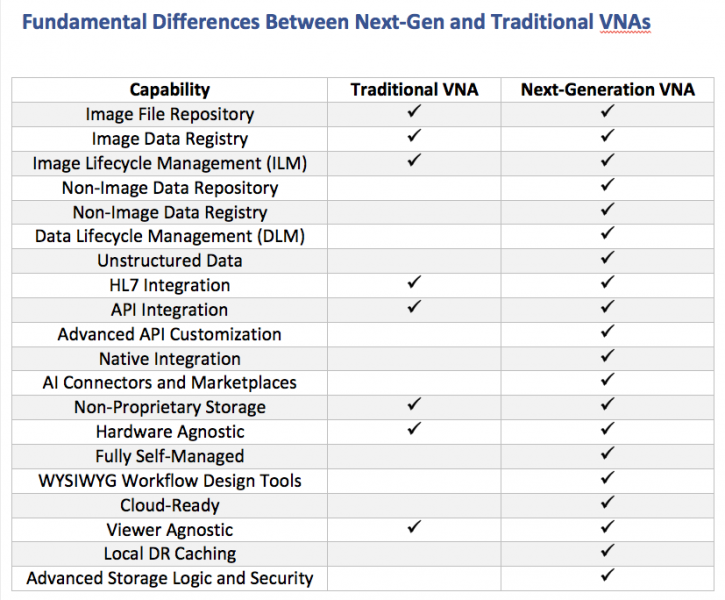
Vendor neutral archives (VNA) have become well-established within enterprise imaging systems of hospitals and clinics around the world. Built on a framework for centralized image storage and exchange, VNAs are rapidly replacing the storage layer of picture archiving and communication systems (PACS) platforms. Much has been written about the virtues of a VNA, while many vendors focus solely on flexible file ingestion and interoperability. Although traditional versions provide the hub for image archiving and management, a modern VNA architecture can leverage capabilities far beyond the fundamentals of file-only archiving when developed with textual data in mind. Progressive-minded vendors are now focusing on next-gen VNA platforms to finally harmonize all clinical information within a single archive and exchange to produce a true health information library.
Next-gen Versus Traditional VNAs
While a traditional file storage VNA focuses entirely on file archiving, the strategy of next-gen VNA leaders is to establish a data layer within the VNA framework for storing textual data (e.g. electronic medical record (EMR), radiological information system (RIS), land information system (LIS) data) in addition to files (PACS and modality imagery). See Figure 1.
To accomplish this, a next-gen VNA incorporates a powerful registry and broker for aggregating all clinical data-types throughout a health enterprise system. Although the new VNA is still relatively transparent to most clinical users, their true value exists as a data library and clinical sharing engine between health information technology (HIT) devices, regardless if they are image producing or textual. In essence, these platforms must be able to not only centralize and manage multi-archive enterprise environments, but also all other data producing objects in a healthcare ecosystem.
Data Liquidity
Freeing data from interoperability constraints and vendor control is critical for seamless integration of HIT systems. Data must be stored centrally, structured or unstructured, and must be highly distributable and accessible. Although many traditional vendors promise data liquidity, a next-gen VNA ensures all levels of data liquidity through a fundamental commitment to data exchange. This means data is free to move from system to system while remaining in a custodian-owned nonproprietary format and all files and databases must be readily accessible by clinical, administrative and analytics tools. Data must flow as rapidly as if it was local to native systems, while stored remotely within the VNA and supplementing ancillary systems from other enterprise objects. Multi-PACS and multi-vendor VNA-to-VNA integrations have become increasingly common in healthcare system mergers and acquisitions, consolidations and integrated delivery networks (IDN), which require all systems to function independently while synchronizing harmoniously. Next-gen VNA provides transparent layers of integration by enhancing interoperability standards such as imaging object change management (IOCM) and integrating the healthcare enterprise (IHE), and establishing advanced connection methods to produce a fully transparent and fluid data exchange engine.
Advanced Capabilities
One major advantage of a next-gen VNA is an access-from-anywhere architecture while providing a seamless presence to sustain undisrupted business operations. Optimum platform fault tolerance, business continuity and zero downtime is crucial to sustaining clinical operations in a diverse technical architecture. An enterprise VNA is business-critical and must be 100 percent available, regardless of point of failure. next-gen VNA provides business continuity with a fully redundant cloud infrastructure coupled to hospital-side local caching to mitigate effects of Internet disruption. Combined, this method of architecture provides a fast, reliable, and scalable archive technology.
Next-gen VNA also provides an exceptional level of administration, alerting, monitoring, self-migration and exceptions workflow tools well beyond traditional VNA. And because their advanced tools are facilitated by common web browser capabilities, administrators are free from complex application-level administration modules. Cumbersome application-level modules have been replaced by WYSIWYG (what you see is what you get) drag-and-drop design tools accessible directly from within a browser window. Their ease of use provides minimal time and effort to maintain the system while eliminating much of the proprietary skill sets required for application-level administration.
Harmonizing Clinical Data
By eliminating data restrictions, simplifying administration and providing robust communication tools, a next-gen VNA acts as an exchange hub for enhanced care coordination. This means it acts as a data orchestrator for harmonizing all data between other HIT systems such as EMRs, RIS, PACS and modalities. As other systems feed data into it, the native data source is free to use the data as it was designed while the VNA provides data collected from all other connected systems containing image and textual data. The VNA transparently brokers all information and seamlessly provides it to connect systems as though those systems were providing their own data. For example, a native integration between a next-gen VNA and an enterprise diagnostic viewer may rely on the VNA for data while only utilizing the viewer’s advanced rendering layer, producing incredibly fast load times and a full view into an enterprise image library. A native integration of this type facilitates real-time access to enterprise imagery without shipping DICOM data back-and-forth between the viewer and archive, or large viewer caches which can be prone to synchronization issues. Additionally, leading viewer providers have developed advanced capabilities to assemble, structure and visualize a next-gen VNA’s library of records which now include textual datasets. This means modality-level imagery and associated textual data can be ergonomically visualized within a single pane through data overlays, as opposed to the traditional method of viewing data from separate applications.
Unlocking the VNA’s Full Potential
While a traditional VNA may provide essential image archiving for enterprise image management, a next-gen VNA utilizes a data framework for archiving and to provide a comprehensive health information library. With a well-established clinical library, an organization can easily exploit emerging tools such as machine learning, artificial intelligence (AI) and analytics for care coordination, population health and outcomes tracking. For example, implementing AI in a diverse environment with a traditional VNA requires extensive effort to connect, normalize and synchronize all data library sources. By implementing a next-gen VNA, all structured and unstructured data is ingested by the VNA, indexed and stored within a single archive for a simplified single-point integration. next-gen VNAs have prepared for this by establishing integration points to connect with third-party AI connectors and AI marketplaces. The result is faster and cleaner data integrations that produce accurate datasets for analysis. The outcome of this cleansed and cataloged data is robust clinical information for diagnosis, stronger AI decision-making, and meaningful analytics across a longitudinal patient jacket and population portfolio.
Dave Whitney is a recognized business leader in radiology, imaging, and healthcare platform design and innovation. He provides subject matter expertise in the fields of medical imaging, driving radiology practice success, business collaboration and publisher of healthcare thought leadership.




 December 04, 2025
December 04, 2025 









